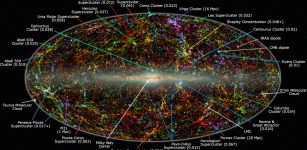Comet Swift-Tuttle: Largest Known Object That Repeatedly Passes Near Earth
Question: What is the connection between comet Swift-Tuttle and the Perseid meteor shower?
Answer: Comet Swift-Tuttle, whose debris creates the Perseids, is the largest object known to make repeated passes near Earth. While the comet poses no threat to the planet for the foreseeable future, it is a very large object. Its nucleus of 6 miles (9.7 kilometers) in diameter is about the same size as the one that crashed into Earth about 66 million years ago and killed the dinosaurs.
The Perseids meteor shower happens every August. Swift-Tuttle was discovered independently by two astronomers, Lewis Swift and Horace Tuttle, in 1862. When it last made a pass by Earth in 1992, it was too faint to be seen with the naked eye. The next pass, in 2126, could make it a naked-eye comet similar in brightness to the 1997 Hale-Bopp comet — providing that predictions are correct.
See also: Vredefort Crater Is The Largest And Oldest Impact Crater On Earth
A prediction from a few years ago said that Swift-Tuttle could collide with Earth during its next pass, but examining the record of past comets showed that its orbit is far more stable than that. Swift-Tuttle poses no danger to Earth for the foreseeable future, although in a millennium it is expected to pass within a million miles (1.7 million kilometers) of the planet.
MessageToEagle.com
Source:
Image credit: NASA/MSFC/D. Moser, NASA’s Meteoroid Environment Office
Related Posts
-
 Ancient France Was Once An Exotic Rainforest And Had Amazon-Like Jungles
No Comments | Sep 18, 2016
Ancient France Was Once An Exotic Rainforest And Had Amazon-Like Jungles
No Comments | Sep 18, 2016 -
 The ‘Walking Under Ladder’ Superstition Can Be Traced To Ancient Egypt
No Comments | Aug 26, 2015
The ‘Walking Under Ladder’ Superstition Can Be Traced To Ancient Egypt
No Comments | Aug 26, 2015 -
 Moths Are Masters Of Disguise
No Comments | May 4, 2016
Moths Are Masters Of Disguise
No Comments | May 4, 2016 -
 Seychelles Islands Are Sinking And Will Soon Disappear Underwater
No Comments | Jun 10, 2016
Seychelles Islands Are Sinking And Will Soon Disappear Underwater
No Comments | Jun 10, 2016 -
 Comet Hyakutake Has The Longest Tail Ever Recorded
No Comments | Jan 8, 2016
Comet Hyakutake Has The Longest Tail Ever Recorded
No Comments | Jan 8, 2016 -
 Lost Technology Of The Ancients – The Crystal Sun
No Comments | Mar 15, 2020
Lost Technology Of The Ancients – The Crystal Sun
No Comments | Mar 15, 2020 -
 Great Attractor: Mysterious Gravitational Anomaly Beyond Hydra-Centaurus Supercluster
No Comments | Jun 4, 2017
Great Attractor: Mysterious Gravitational Anomaly Beyond Hydra-Centaurus Supercluster
No Comments | Jun 4, 2017 -
 Fantastic Biological Street Lighting: Using Glowing Plants And Trees As An Energy Source
No Comments | Jun 2, 2016
Fantastic Biological Street Lighting: Using Glowing Plants And Trees As An Energy Source
No Comments | Jun 2, 2016 -
 Time Moves Faster The Farther Away You Are From The Surface Of The Earth
No Comments | Jan 30, 2016
Time Moves Faster The Farther Away You Are From The Surface Of The Earth
No Comments | Jan 30, 2016 -
 Lake Baikal Is The Deepest And Oldest Lake In The World
No Comments | Jan 24, 2016
Lake Baikal Is The Deepest And Oldest Lake In The World
No Comments | Jan 24, 2016

